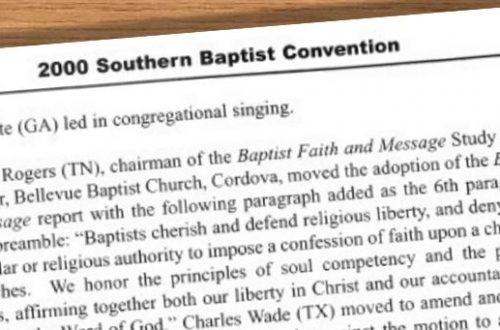 The Council for Biblical Manhood and Womanhood (CBMW) launched a new website over the weekend. If you haven’t seen it yet, you need to check it out: www.CBMW.org. There are many resources available for free, including every single back issue of the Journal for Biblical Manhood & Womanhood. There is even a “Gender Blog” to which you can subscribe. Also, don’t miss the sermon audio section.
The Council for Biblical Manhood and Womanhood (CBMW) launched a new website over the weekend. If you haven’t seen it yet, you need to check it out: www.CBMW.org. There are many resources available for free, including every single back issue of the Journal for Biblical Manhood & Womanhood. There is even a “Gender Blog” to which you can subscribe. Also, don’t miss the sermon audio section.




4 Comments
Pingback:
Sue
I’m stymied. I just listened to Lig Duncan on Bib M & W. He says that all males and females, young and old, are supposed to demonstrate the differences in design between males and females. But the only differences he mentions is that men are more susceptible to sexual temptation and women to wanting to be like their noncomplementarian sisters. I think that’s it.
But Ware says that the role difference centers on hierarchy. How does putting men in charge combat their susceptibility to temptation? Does giving men authority over women combat men’s sexual temptation or feed it?
I always feel I just don’t understand how one can say that the basis of the authority role and the submissive role is the difference in design, and yet still maintain that men and woman are equal. That is, are women designed for submission, how so, and if so, how are women capable of leading in the secular field, and how do they function as single women missionaries. How do women have the natural function of leadership, if a design difference underlies the role difference, and the role of women is followership.
Or is the difference in design not related to authority and submission. But Duncan says that it is. I can’t make one end of the argument match the other end.
Sue
February 5, 2007 Different by Design 2007, Session 2
Matthew
It looks nice – more modern than before. But, like before, I wish it had a clearer route to helpful information for wives and children of abusive husbands and dads. Unless I am missing it, none of the 53 articles listed under “Resources” directly addresses victims of abuse. You can search for “abuse.” The result set is not terribly helpful at this time. It contains the statement against abuse (a good start), links to a couple articles about abuse – but the links are broken: they only go to the archive page and it is difficult to get to the desired text, as well as defenses against the charge that complementarianism is itself abusive – those links are also broken. At present, if I were the wife of an abusive husband, I am not sure I would be able to divine any practical suggestions for what action to take. This means
Here is an example of a broken link: http://www.cbmw.org/resources/reviews/womeninministry1.php According to my search results, that link should contain the text: “These thinly veiled euphemisms stop just short of implying that complementarians advocate oppression and abuse of women. …” But instead, it redirects to a page of 20 out of 53 book reviews. It is not clear which book review the text occurs in. Same for articles that link to old journals. It is not clear which journal, let alone which article, to read.